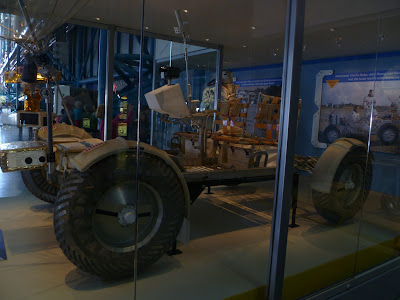Our second stop on the Kennedy Space Center bus tour in early February, 2013, was the Apollo / Saturn V Center. Entering the center, we were ushered into grandstand type seating behind the actual Apollo firing room consoles and witnessed a launch countdown. The firing room exit led us to the huge exhibition hall that houses a complete Saturn V rocket mounted horizontally along the center of the hall.
 |
| Looking down the exhibit hall from the first stage toward the command module |
The Saturn V rocket is separated into its various stages for display. With the Apollo capsule, the complete Saturn V rocket was 363 feet tall with a diameter of 33 feet at the base, not counting the fins. When fully loaded with fuel, the rocket weighed 6.5 million pounds and was capable of delivering a 260,000 payload into low earth orbit. The rocket consisted of three stages plus the instrument unit. The S-IC first stage consisted of five F-1 engines fueled by RP-1 rocket fuel with liquid oxygen (LOx) as an oxidizer. RP-1 is a highly refined form of kerosene. Each F-1 engine had a thrust of 1.5 million pounds or more than the three shuttle main engines combined.
 |
| The five F-1 engines of the Saturn V first stage |
The S-II second stage consisted of five J-2 engines fueled by liquid hydrogen and LOx. Each J-2 engine had a thrust of 232,250 pounds in a vacuum or 109,302 pounds at sea level.
 |
| The five J-2 engines of the second stage (note the golden frame at the top of the first stage is only a museum mount and not flight hardware) |
 |
| Instrument Unit |
The S-IVB third stage consisted of one J-2 engine. Mounted to the top of third stage was the tapered enclosure for the Lunar Module (LM).
 |
| The single J-2 engine of the third stage |
The Command/Service Module used an AJ10-137 engine using Aerozine 50 fuel and nitrogen tetroxide as oxidizer.
 |
| Command / Service Module (CSM) |
The Command Module is the only portion of the Apollo / Saturn designed to return to the earth. It was only 10.6 feet tall and 12.8 feet in diameter and weighed 12,250 pounds.
 |
| Apollo 14 Command Module Kitty Hawk |
 |
| Lunar Module |
 |
| Lunar Module interior |
 |
| Lunar Rover |
 |
| Lunar Tool Cart |
 |
| Alan Shepard's Apollo 14 spacesuit |
 |
| Moon Rock |
Taking a cue from Disney World just up the road, the exit from the exhibit hall to the bus loading area is through a large gift shop. Returning to the visitor center complex, the bus driver pointed out several alligators near the road. At the visitor center, we had time to watch "Hubble 3-D" an excellent IMAX® movie about the final repair mission to the venerable space telescope.
Admission for one day at the Visitor Center and two days at the Astronaut Hall of Fame is $50 for an adult and $40 for children ages 3 through 11. Admission includes the bus tour and both IMAX® movies. Parking is an additional $10 per automobile or motorcycle and $15 per motor home.
The Space Center website is http://www.kennedyspacecenter.com.

Very cool! My father-in-law worked on some of the Saturn & Apollo projects and it's always cool to see NASA gear.
ReplyDelete